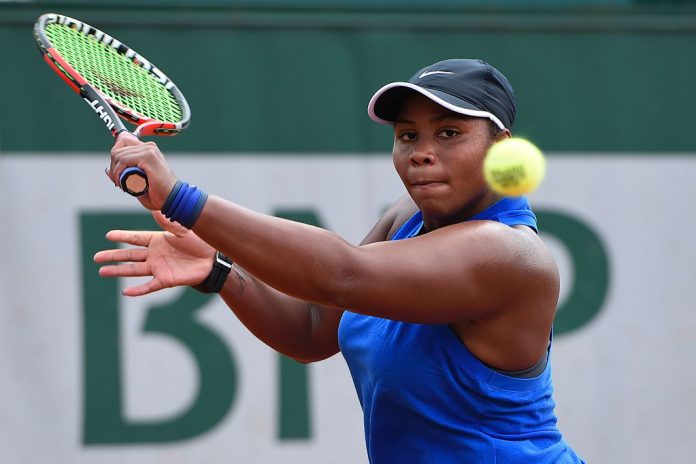Body Issues, Body Shaming and the Journey of an African-American Talent
By Michael Mewshaw
As a precociously talented 18-year-old, Taylor Townsend stormed into Paris in 2014 like one of those spring rains that periodically sweep over Roland Garros. She brought along with her a tempest of another type – a debate among tennis aficionados about her weight and conditioning. Some emphatically declared that she was out of shape. Others complained she was being fat-shamed and racially stereotyped for not being a slim blond in the Sharapova mode. For the first week of the French Open the debate seemed moot. Townsend, a stylish lefty with surprising touch for a player of her power, took out Vania King in the first round, then Alize Cornet, a top twenty French favorite, in the second. Though she lost in the third round to the Spanish veteran Carla Suarez-Navarro, Townsend appeared poised to fulfill her considerable potential. By the end of the year she had reached a career-high ranking of 94.
Then as 2015 unfolded, the bottom fell out, and the naysayers looked primed to claim they were right. In challenger event after challenger event Townsend lost in the first round. She had even less luck on the main WTA tour. By the end of 2015 she had plummeted to 304 and was floundering – big time. What followed, however, was a slow rung-by-rung climb back up the ladder. Still sturdily built, still no PR person’s cliché picture of a female tennis champion, she put together a run of good results this spring, capped by the title at a challenger in Charlottesville, Virginia. This got her a wild card into the French Open, where she beat Frenchwoman Amandine Hesse, in the first round. In her next match, the competition stiffened as she confronted Elena Svitolina, a Ukrainian only a year-and-a-half older than Townsend, but already a fixture in the top twenty.
I watched the match with Damon Austin, an African American who has worked with a number of world-class players and now coaches in the Washington DC suburbs at DeMatha, a Catholic boys school nationally renowned for its basketball and football programs which have sent dozens of players to the pros. Austin’s ambition is to transform DeMatha into a tennis powerhouse, drawing on the same pool of inner city kids as the football and basketball teams do.
A broad, strongly built fellow of 47, Austin had a non-judgmental view of the much-debated issues relating to Taylor Townsend’s body, while conceding that she had bigger legs and shoulders than most female players – “just like Serena Williams” – he added. “That’s her natural physical make-up. There’s nothing about that that hinders her as an athlete. Sure, if she improved her fitness, her performance would improve. But she has the tools to fulfill her potential. Already she’s faster than most women in the game, and she has a good sense of the court, a soft touch at the net, and an excellent overhead.”
Everything Austin said might be true, I observed, but that didn’t change the fact that Svitolina outclassed Townsend in the first set 6-3, then bageled her in the second. How did he square that with his high assessment of the American girl?
For him it was a simple question. “Svitolina is a smart, experienced competitor. She takes the ball early and redirects it, making Taylor stop and start and change directions. Like most Americans, she has trouble on clay. It’s her least favorite surface. Americans just don’t have a knack for sliding. Still, I see nothing but an upside for Taylor.”
Damon Austin may be in the minority with his opinion, but he defends it well and even offers a coherent if slightly unorthodox, plan to bring her up to Elena Svitolina’s level. “I believe that right now she has the talent to be a top 10 doubles player. I believe that’s the shortest path to success for her. I’m not suggesting she become a doubles specialist. But if she maximized her ability in doubles, she’d find herself practicing with and playing against better and better players. My view is that success breeds success. Good results in doubles could carry over to singles, and she has the tools to be in the top 20 or 30.”
When I tried to steer the interview back to the issue of Townsend’s conditioning, Damon Austin insisted on writing out his response to ensure he was accurately quoted. “To say Townsend or Williams or any other female tennis athlete of African descent is hindered by her weight fails to consider the deeper issue of insufficient statistical sampling. To claim they are ‘out of shape’ is misleading. There simply have not been enough black women in elite level tennis to theorize how an average ‘fit’ black female athlete performs. There has never existed a control group of her peers to draw an informed conclusion.”
While this may not end the debate, it certainly gives it a push in a provocative direction.
Michael Mewshaw is the author of Ad In Ad Out, a collection of his article about tennis, published as an e-book on amazon.com.



















